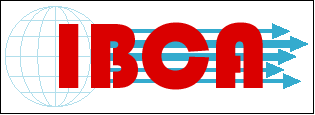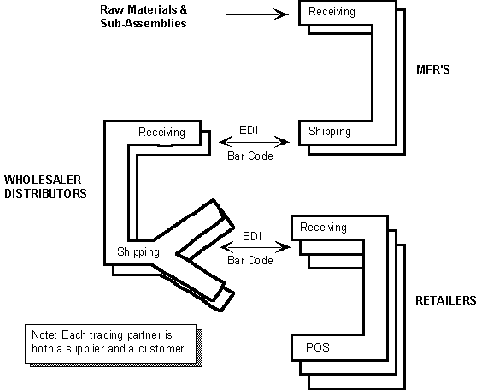

MANUFACTURERS Guide to Bar Code, Common Forms and EC/EDI
2. Overview
When a customer asks a vendor to apply a bar code label or lose their business, the benefits are easy to estimate. To be more accurate, some of the benefits are easy to estimate. Others take digging to identify and quantify.
Time and experience have shown that manual data collection and data entry systems (handwritten documents followed by keyboard data entry) are cost drivers for three reasons:
| Manual data collection is slow and error prone. Bar code is significantly faster (about 15 times) and more accurate (about 10,000 times) than manual data entry systems. | |
| Manual data collection systems tend to be batch oriented so data bases are often out of date. Bar code data entry can save hours or even days of the "Information Float" period. "Information Float" is the time between an event occurring and the information system knowing it occurred, i.e. the time it takes to enter a receiving transaction or the completion of a specific manufacturing operation, etc. | |
| Manual data collection is so expensive and error prone that companies are discouraged from collecting important information. Realizing the problems of collecting data manually, many companies don’t collect data that they should. |
The consequences of these problems are significantly higher costs that ripple throughout an entire organization –– even entire industries.
2.1 Examples of Benefits to Individual Companies
An investment in bar code , or any other technology for that matter, can pay for itself in three ways:
| Increasing Sales; | |
| Improving Gross Margins; | |
| Reducing Overhead. |
Some benefits, like keeping a customer’s business, can be easily measured. Others, like increasing sales due to improved customer service, are more difficult to predict with any certainty.
Any bar code application can be analyzed by its impact on sales, gross margins and overhead. Consider the following two examples.
The cost of inaccurate inventory records.
Theoretically, inventory records should always be perfectly accurate. If every transaction is recorded in "real time," the inventory will be accurate. Realistically, however, day–to–day mistakes throw the accuracy off. One solution is to take inventory more often in order to detect the cause of the inaccuracies.
Unfortunately, taking inventory with traditional methods is not a pleasant task and sometimes this fact discourages companies from counting inventory as often they should. This leads to inaccurate inventories: not knowing what is on hand or where it is stored. The consequences of inaccurate inventories can be felt throughout a business. For example:
Lost sales
| If you tell a customer you don’t have something when you do, you may lose a sale. | |
| If you miss a delivery date, or you lose orders, retail shelves are bare. | |
| Damaging your reputation with a customer due to late deliveries or not having what they need eventually causes lost sales. |
Lower Margins
| Buy from a competitor to supply a product you thought you had but didn’t; your margins suffer. | |
| Tell a customer to keep a product shipped by mistake rather than pay to have it returned. | |
| Pay RUSH transportation costs to expedite an item you thought you had but didn’t. | |
| Pay higher prices to a vendor to drop ship a small quantity of product because you didn’t have something you thought you had. |
Higher Overhead
| Inaccurate inventories often lead to purchasing buffer inventories which causes lower inventory turns. | |
| Lower material handling productivity. The productivity of material handlers can be reduced if inventory records are inaccurate because they waste time trying to find merchandise. |
For all the reasons stated above, bar code is frequently used to take annual physical inventories and conduct cycle counts because using bar code is easier, more accurate and faster than manual methods.
The Cost of Picking & Shipping Errors
When the wrong product or the wrong quantity of the right product is sent to a customer, it initiates several costs.
Lost Sales
| Lower sales force productivity. Shipping errors irritate customers. They take it out on the sales force. Rather than selling, the sales force winds up apologizing and spending time and money trying to keep a customer. | |
| Undetected over-shipments lead to inventory inaccuracies which can lead to lost sales. |
Lower Margins
| Undetected over-shipments by definition are shipments with no corresponding invoice. This shows up as reduced overall gross margins. |
Higher Overhead
| Customers frequently delay paying incorrect invoices … even if most of the invoice is correct. Delayed payment reduces cash flow and increases borrowing costs. | |
| Picking up the incorrect merchandise and re-shipping the proper merchandise increases transportation costs, with "overnight" charges or even salespeople or other personnel making deliveries. | |
| Material handling productivity is reduced if merchandise shipped in error needs to be re-stocked and if the correct merchandise needs to be picked again. | |
| Issuing credits and rebills (debit memos) consumes administrative time and money. Some portion of one or more person’s salary goes to researching these errors and issuing the necessary paperwork. |
Example:
A company issues 200 invoices per day, 240 days a year. They process 10 credits / rebills a day (5%). Half of these were because they made a picking, packing or shipping error (5 per day). The other half are customer errors or errors out of their direct control. The total number of errors under their control per year is 1,200 (5 per day @ 240 days). At an average cost of $75.00 per error (administrative, material handling, transportation, etc.), the total cost of errors is $90,000 a year.
If the company is earning 5% pre-tax profit, this is the equivalent of a $1,800,000 customer! And even if you are only shipping 50 invoices a day, it's still like a $450,000 customer.
In fact, the actual cost may be double this amount since the detected errors are brought to your attention by customers when you make an error in your favor. Errors in their favor may never be reported. You notice them as inexplicable low gross margins or inventory adjustments.
Note: Shipping errors drive costs at both the sender and the receiver side. The costs described above don’t include the cost to the recipient and should be included in the overall cost of errors to an industry.
Bar code -assisted order picking and shipping verifications systems pay for themselves by reducing these costly errors.
2.2 Summary of Company Benefits
Within organizations, bar code has proven its ability to help companies compete better. A few of the documented benefits are listed below:
| improved on-time fill rates. | |
| reduced inventory carrying costs. | |
| accurate and timely reporting of POS information. | |
| increased material handling productivity. | |
| identification of production bottlenecks. | |
| increased inventory accuracy. | |
| reduced data entry costs. | |
| reduced picking and shipping errors. | |
| increased sales. | |
| reduced buffer inventories. |
Any one of these benefits is worth pursuing, but when U.P.C. numbering, bar code and EC/EDI are implemented throughout an industry, individual members of that industry can achieve meaningful gains in all of them and help entire industries remain competitive!
2.3 Industry Benefits
Manufacturers, distributors and retailers conduct thousands of business transactions every day. Many of these transactions involve the communication of item numbers and quantities. Most transactions start out as handwritten documents, followed by a phone conversation or computer generated report which is ultimately FAXed or mailed to a trading partner.
In many cases, products pass through the entire distribution channel without being changed at all, so translating to proprietary item numbers is an unnecessary and error–inducing step. A bird’s eye view of the relationships between trading partners looks like this:
Bird’s Eye View of Trading Partner Material and Information Flow

Instead of using proprietary item numbers requiring multiple translations, retailers, distributors and manufacturers can use standard numbering systems and bar code and/or EC/EDI to record sales, receive merchandise, place orders, count inventories, verify shipments, and record storage locations. As unnecessary costs associated with using proprietary numbering schemes are removed from the distribution pipeline, entire industries become more competitive.
With improved accuracy and timeliness of POS data, retailers can control their inventory better, increasing sales by stocking the proper merchandise and reducing unplanned mark–downs. Using bar code to track work in progress helps manufacturers identify production bottlenecks and improve deliveries while reducing inventory carrying costs. Distributors using bar code and U.P.C. numbers can improve inventory accuracy, on-time fill rates and reduce inventory carrying costs.
2.4 Final Thoughts on the Benefits of Bar Code
Tracing the actual benefits of using bar code instead of manual data collection systems is true detective work. It takes time but it can be very rewarding because it can improve sales, improve gross margins and reduce overhead.
Companies using the U.P.C. standard numbering system and bar code are not pioneers. Fortunately, each of these communication technologies has already been tested and implemented successfully in many industries.